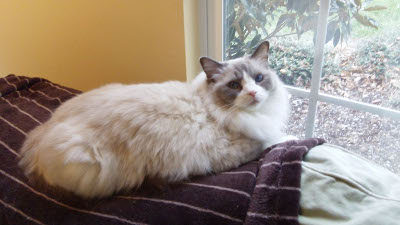How a natural diet saved our cat’s life
by Amy Butchko, Guest Blogger
My husband Michael and I have been followers of the nutritional advice of the Weston A. Price Foundation and subscribers to the Hartke is Online! blog for several years, and we’ve seen great results in our health. This post is not about us though; it’s about how we used what we’ve learned about natural diets to totally turn around the health of a very sweet but very sick cat.
Shadow is our nearly 4 year old Ragdoll cat. In December of 2010 (when he was not yet 3), Shadow started running a high fever and Michael rushed him to the emergency vet where they ran all kinds of tests, and the results were bad: Shadow had a cardiomyopathy, which could shorten his life dramatically, he’d have to be on prescriptions and he’d need regular ultrasounds to track the progression of the disease.
We were devastated, and part of the reason was we knew we’d had a role in all this. For ourselves, we’d chosen grassfed meats, organic veggies and were careful with grains. I’d taken Monica Corrado’s cooking classes, and we were “all aboard” a whole foods lifestyle. For our cats, we were feeding a store-bought kibble and canned organic food. We knew it was just “ok”, but we had no idea the danger we’d put our cat in with this decision.
We’d talked about switching to raw food, but we just didn’t know where to start. Now, we knew we had to figure it out.
Transitioning to a Raw Food Diet
We started with a book: Whole Health for Happy Cats, and decided to make one batch to find out if our cats would eat it. In addition to Shadow, we have Clementine, a Siberian who we were also going to switch to raw. We knew this was no small feat: cats will often reject changes to their diets.
It’s now a year later, and I’m thrilled to report that both cats are happily on a raw diet. Shadow lost about 5 pounds out of his belly when we switched, but added the weight back in muscle within a couple of months. He is so strong now! He can jump and run and has the energy of a kitten. He’s on no prescriptions, and we don’t do any other interventions for his health other than create great food for him to eat.
This has been a remarkable experience, exceeding all of our expectations. In the videos below, you’ll see exactly what we do 4 times a year to make sure our two cats have the best possible diet for their situation.
Here are the videos:
And, if you need the resources in the videos, here are some links that will send you there:
Visit my Wellness Works Amazon store for supplies.
Get the spreadsheet conversion recipe chart.
This is a picture of the finished product before we run it down to the freezer, 41 containers! It’s not an easy thing: creating all this food takes a minimum of 3 hours for the amount we make (we use chickens from our WAPF farmer), and we had to acquire some supplies like a meat grinder that are a little out of the ordinary for this raw food diet.
On the other hand, the results are two healthy cats and two cat parents (us) who are a lot less stressed. We don’t have to worry about catastrophic decisions or stress and bills coming from visits to the vet anymore. And we know that we’ll have our two companions with us for a long, long time eating their natural raw food diet.
Here’s part of the fan club: Clementine eating her raw food diet breakfast.
Amy Butchko blogs and publishes an ezine about life, work, parenting and fitting a little bit of healthy livin’ into 168 hours a week. Visit her online at www.wellnessworksllc.net.
This post is part of the Real Food Wednesday blog carnival. See more kibbles and bits at Kellythekitchenkop.com.
Editors Note: And, if you are sick, check out Recipes for Life a book about a raw food diet for people! This book got a thumbs up review from Sally Fallon Morell, President of the Weston A. Price Foundation.





A grassfed farmer I know had a dog that was hit by a truck. One of the the dogs legs was so badly shattered that the vet said it could never heal, and the dog should be put down. My friend decided to switch the dog to a totally raw meat diet, consisting of grassfed beef, grassfed fat, grassfed bones, and grassfed organ meats. Within two months, the dog was completely healed, and normal and healthy in every way.
I switched my dog to a raw diet this past Summer, and it has been a great experience. She has thrived on it, and seems better in every way. It really is the best diet for cats and dogs.
Wow, Stan, what a story! Thanks for posting that!
Feeding your pets raw doesn’t have to be a lot of work. In the beginning it might be, especially for cats, since you have to convince them that you are indeed giving them food.
But once they transition over to raw, you can give them chunks of meat right out of the fridge. My cats eat hunks of chicken, beef, pork, goat, deer, and rabbit (as well as organ meat from them). For bone, they get whole chicken necks or bone-in chicken breast. Same thing for my dog (who just recently passed of old age). He was a large dog, so he got deer legs too.
As long as you keep the ratio of 80% meat, 10% bone, and 10% organ (half of which should be liver), you’ll have healthy pets. Feed 2-3% of body weight per day. Supplements aren’t needed if you are feeding appropriately (unless you are treating a specific health condition).
I started feeding raw to my cats when I owned one cat who was diabetic and needed insulin twice a day and two cats who blocked with urinary crystals. I was feeding a premium kibble at the time. Fortunately I had been feeding my cats a wide variety of treats, so they were all on board with raw. (cats learn what foods are food from their mother when they are kittens. Once that window is closed, transitioning to new previously untried foods is difficult - but not impossible) My diabetic cat went from needing 7 units of insulin twice a day to 1-2. I found the recipe I used at http://www.catinfo.org You don’t have to make it to feed raw though. There are several makers of decent raw cat food, Feline’s Pride is one of them.
I foster kittens from a local shelter, and I get constant reminders that proper nutrition can do wonders.
Congratulations on transitioning your cats to a raw food diet. I’ve been feeding my cats raw since 1993, some of them since birth. I have an 18-year-old (who eats a whole mouse almost every morning and ground turkey at night) and a 17-1/2-year-old along with younger cats who hardly ever get sick. We just don’t bother with vets anymore if we can help it.
I have to say that you folks are working way too hard. First, for cutting up the chicken, use a chef’s knife for cutting off wings and legs and then cut through the upper and lower half of the chicken to cut it in half. Than use a cleaver on a WOOD cutting board to chop up the chicken. You should be able to process one in under 3 minutes.
And your cats don’t need all those supplements. They will need additional taurine, since freezing damages it, so just add organ meat. Additionally, cats need the exercise of chewing whole bones for their jaws and gums, which also cleans their teeth. Instead of grinding all of it, just grind some, and give them chunk chicken. Add other animals as well, such as rabbit and ground turkey. (You won’t be able to grind the turkey yourselves, though. Bones are too big.) I don’t think feeding them only one animal is healthy.
A typical weekly diet in my house is:
Monday: ground turkey, bones and organs with chicken hearts
Tuesday: chunk cornish game hen
Wednesday: chunk rabbit
Thursday: ground turkey, bones and organs with sardines (for iodine and omega-3)
Friday: chunk cornish game hen with chicken liver
Saturday: ground turkey, bones and organs with egg yolk and chicken hearts
Sunday: ground rabbit, bones and organs
They also have access to a planter of wheatgrass and they get pieces of vegetables I’m preparing for myself if they want them: rib of romaine, broccoli, avocado, cucumber, kale. A few of my cats also like thawed frozen mice and baby quail.
And for those who don’t want to grind their own meat, I purchase my ground meat from Hare-Today in PA. They are very affordable and ship nationwide.
If you’d like to know more about the benefits of the raw diet, you can listen to my interview with Margaret Gates, founder and director of the Feline Nutrition Education Society: Feeding Your Cat a Species-Appropriate, Raw Meat Diet.
Whoops. I meant I’ve been feeding raw since 2003, not 1993.
These comments are really making this a valuable post! I hope many pet lovers find it when searching for answers for their pet’s health problems.
Please send this post to any vet you know. Come to think of it, my brother in-law is a vet!
My old cat, Sweetie, refuses to eat anything but dry packaged cat food. If she was younger, I would probably force the switch, but cats don’t live forever - even on a healthy diet - and she’s going on twelve, and doing pretty well. Nevertheless, about a year ago, I found a cat food in my local natural foods store without artificial ingredients (like food color!) and she tolerates it pretty well.
When I started paying attention to my own diet a few years ago, I also began to think about my kitty’s diet and looking more carefully at pet food ingredients. WHY, for instance, is there CORN, or grain of any kind in food designed for a carnivore? It’s fully impossible to find commercial pet food - even “natural” stuff - that’s not loaded with fillers.
Thanks for this post. I’m going to pass it along to my daughter (who I’m sure will some day become the quintessential “cat lady”). She has two cats, one of whom has some health problems and is extremely overweight. This fat cat will eat anything and will no doubt love the raw food diet.
Excellent, what a weblog it is! This web site presents useful information to us, keep it up.